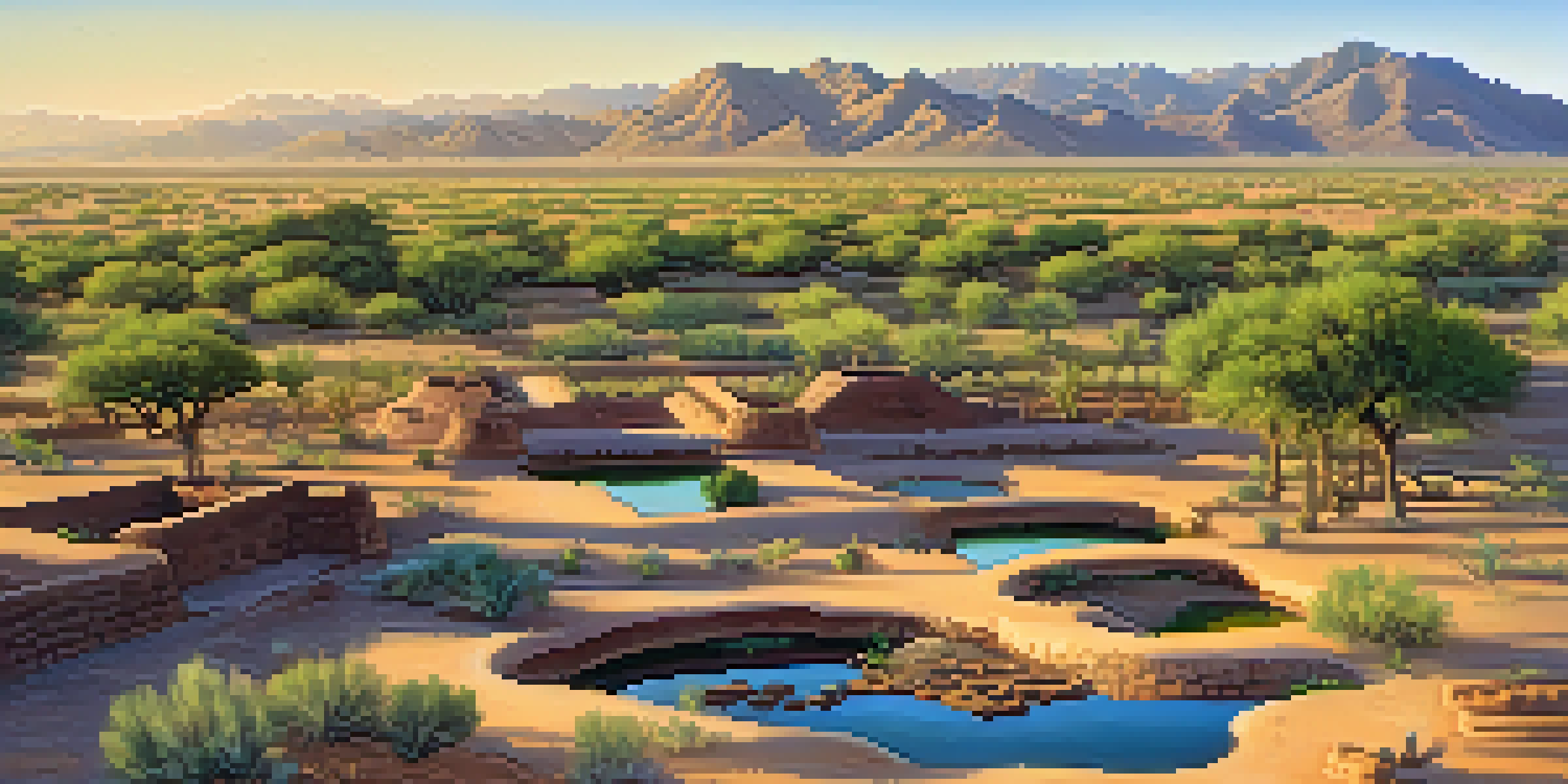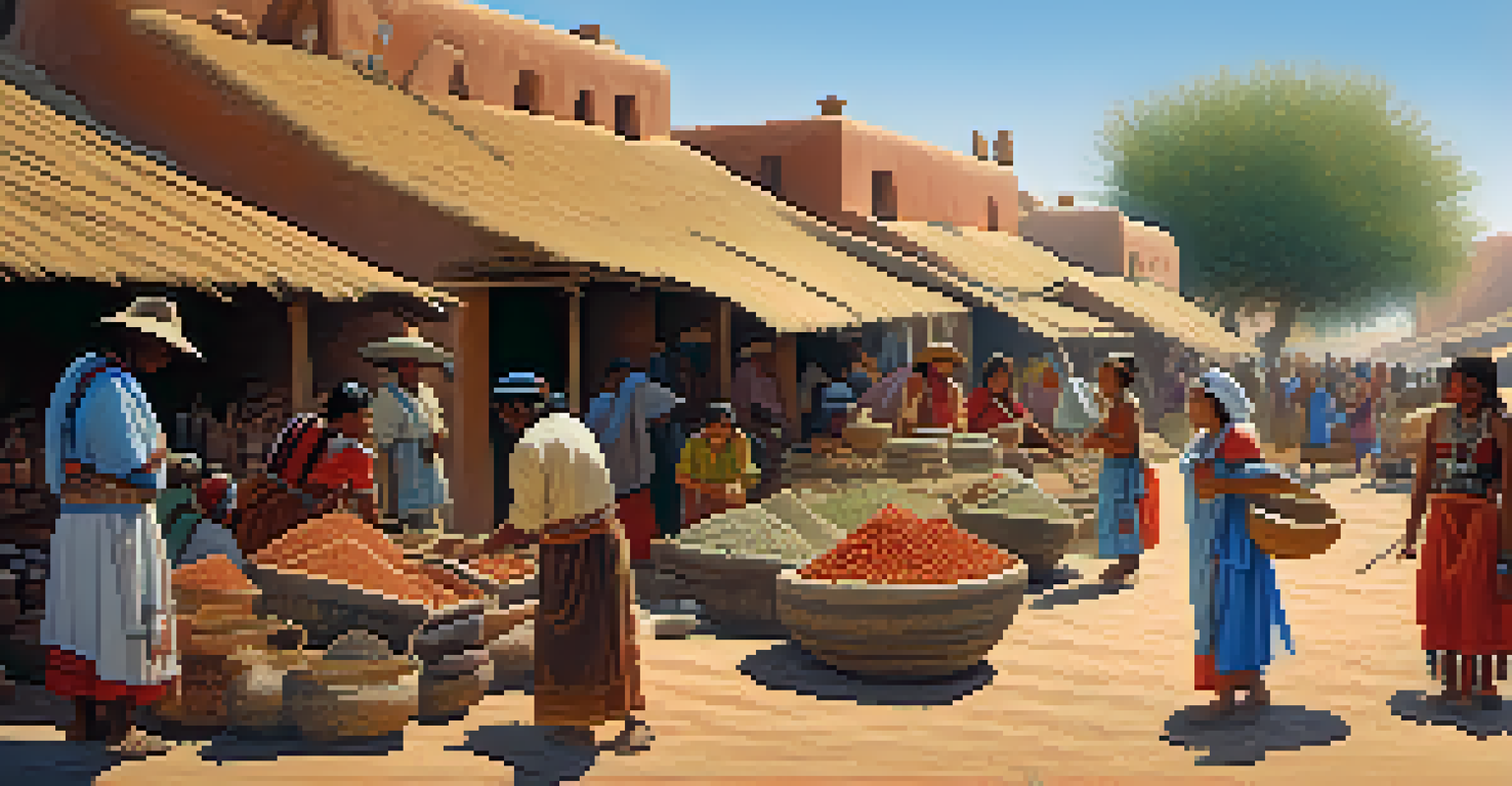Cultural Significance of Hohokam in Phoenix's Heritage

Understanding the Hohokam People and Their Era
The Hohokam were an ancient Native American culture that thrived in the Phoenix area from around 300 AD to 1500 AD. They are best known for their advanced irrigation systems, which allowed them to transform the arid Sonoran Desert into fertile farmland. This innovation not only supported their agricultural practices but also laid the foundation for future communities in the region.
The past is never dead. It's not even past.
Their society was characterized by farming, crafting, and trade, showcasing a rich cultural tapestry that included unique pottery and jewelry. The Hohokam were not isolated; they engaged in extensive trade networks that connected them with other tribes and cultures. This exchange of goods and ideas significantly influenced their development.
Understanding the Hohokam’s way of life provides valuable insights into the early human adaptability to the harsh desert environment. Their ingenuity in water management and agriculture serves as a testament to their resilience and creativity, aspects that continue to resonate in today’s Phoenix.
The Hohokam's Remarkable Irrigation Systems
One of the most remarkable achievements of the Hohokam was their complex irrigation system, which included canals, ditches, and reservoirs. These systems allowed them to harness seasonal floods and distribute water efficiently across their fields. This engineering feat was crucial for sustaining their agricultural economy, enabling them to grow crops like corn, beans, and squash.

The Hohokam's irrigation practices were so advanced that some of their canals are still visible today. These ancient waterways not only supported their farming needs but also demonstrated the community’s collaborative spirit, as maintaining such systems required collective effort. This teamwork fosters a sense of unity that is a core aspect of cultural identity.
Hohokam's Advanced Irrigation Systems
The Hohokam developed complex irrigation systems that transformed the Sonoran Desert into fertile farmland, showcasing their ingenuity and collaborative spirit.
Today, the significance of these irrigation methods is reflected in modern water management practices in Arizona. The principles of sustainability and resource management that the Hohokam employed continue to inform contemporary approaches, highlighting the lasting impact of their ingenuity on the region.
Art and Craftsmanship of the Hohokam
Art and craftsmanship were integral to Hohokam culture, with evidence of their pottery, jewelry, and tools found throughout the region. Their pottery, often adorned with intricate designs, served both functional and ceremonial purposes, showcasing their artistic skills and cultural beliefs. Each piece tells a story, reflecting their values, traditions, and the environment around them.
History is not a burden on the memory but an illumination of the soul.
The Hohokam also excelled in crafting jewelry from materials such as shell and turquoise, which were traded from distant lands. This trade not only enriched their culture but also connected them to a broader network of communities. The artistry in their crafts demonstrates a deep appreciation for beauty and functionality, traits that are still celebrated in contemporary Indigenous art.
Exploring Hohokam artistry allows us to appreciate the cultural significance they placed on aesthetics and craftsmanship. Their legacy lives on in the vibrant arts scene of Phoenix, where many artists draw inspiration from these ancient practices, creating a bridge between past and present.
Hohokam Trade Networks and Cultural Exchange
The Hohokam were not just farmers; they were also skilled traders who established extensive trade routes connecting them to various cultures across the Southwest. They exchanged goods like pottery, tools, and jewelry, which not only enriched their own culture but also facilitated cultural exchanges. This interaction brought new ideas, techniques, and materials into their communities.
Artifacts found in Hohokam sites reveal the diversity of items traded, including copper from Mexico and shell from the Pacific Coast. These findings illustrate the Hohokam's role in a larger economic system that spanned great distances. Such trade relationships fostered a sense of community and interdependence among different tribes.
Cultural Richness Through Trade
Extensive trade networks allowed the Hohokam to exchange goods and ideas, enriching their culture and connecting them with diverse communities across the Southwest.
Today, the legacy of Hohokam trade networks is a reminder of the importance of cultural exchange in shaping societies. It highlights how interconnectedness can lead to innovation and growth, principles that remain relevant in our globalized world.
Religious Beliefs and Practices of the Hohokam
Religion played a central role in the lives of the Hohokam people, influencing their daily activities, agricultural practices, and community events. They believed in a complex spiritual world where natural elements were often revered as deities. This belief system was reflected in their rituals, which included offerings and ceremonies aimed at ensuring bountiful harvests.
Archaeological evidence suggests that the Hohokam engaged in elaborate rituals, including the construction of platform mounds and ball courts, which served as ceremonial and social hubs. These structures were not only significant for their religious practices but also for fostering community cohesion and identity. Such gatherings were vital in reinforcing cultural ties among the members.
Understanding the spiritual beliefs of the Hohokam gives us insight into how they viewed their place in the world. Their reverence for nature and the community spirit encapsulated in their rituals remind us of the importance of connection to the environment and each other, values that resonate deeply in contemporary society.
The Decline and Legacy of the Hohokam Culture
The Hohokam civilization began to decline around the 15th century, and while the reasons remain debated, factors such as climate change and resource depletion likely played significant roles. The once-thriving communities faced challenges, leading to a gradual migration away from the region. Despite this decline, the influence of the Hohokam endures in the cultural fabric of Phoenix.
Their descendants and other Indigenous groups continue to honor Hohokam traditions, from agricultural practices to artistic expressions. The preservation of Hohokam heritage serves as a vital link to the past, highlighting the resilience and ongoing contributions of Indigenous peoples to the region's cultural identity. This legacy is also recognized in local education and heritage programs.
Legacy in Modern Phoenix
The influence of the Hohokam culture is evident today in Phoenix's agricultural practices and artistic expressions, highlighting the importance of honoring Indigenous heritage.
Today, the story of the Hohokam is not merely a chapter in history but a vibrant part of Phoenix's identity. Their achievements remind us of the importance of understanding our roots and the interconnectedness of cultures that shape our communities.
Hohokam Influence on Modern Phoenix
The impact of the Hohokam culture is still evident in modern Phoenix, from the city’s agricultural practices to its water management systems. The ancient irrigation techniques developed by the Hohokam have informed contemporary methods, promoting sustainability in an area known for its desert climate. This connection to the past enriches the city’s identity and informs its future.
Moreover, the Hohokam's art and traditions continue to inspire local artists and cultural events. Many contemporary craftspeople incorporate Hohokam motifs and techniques into their work, creating a living legacy that celebrates their heritage. This blending of past and present fosters a deeper appreciation for the region's rich history.

As Phoenix continues to grow, embracing its Hohokam roots is essential for fostering community pride and cultural awareness. Understanding the cultural significance of the Hohokam not only honors their legacy but also encourages a more inclusive narrative that recognizes the contributions of Indigenous peoples to the city’s development.